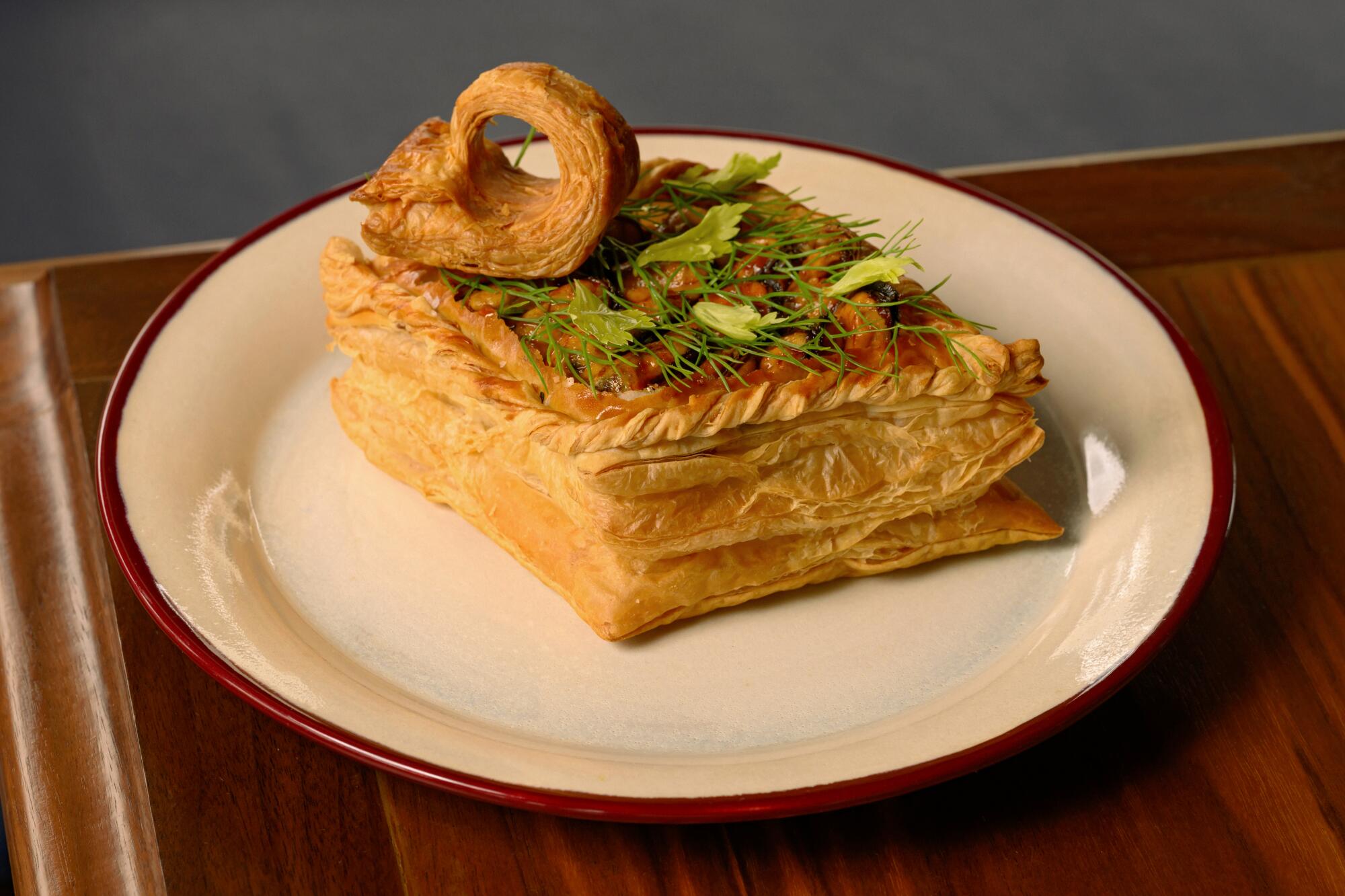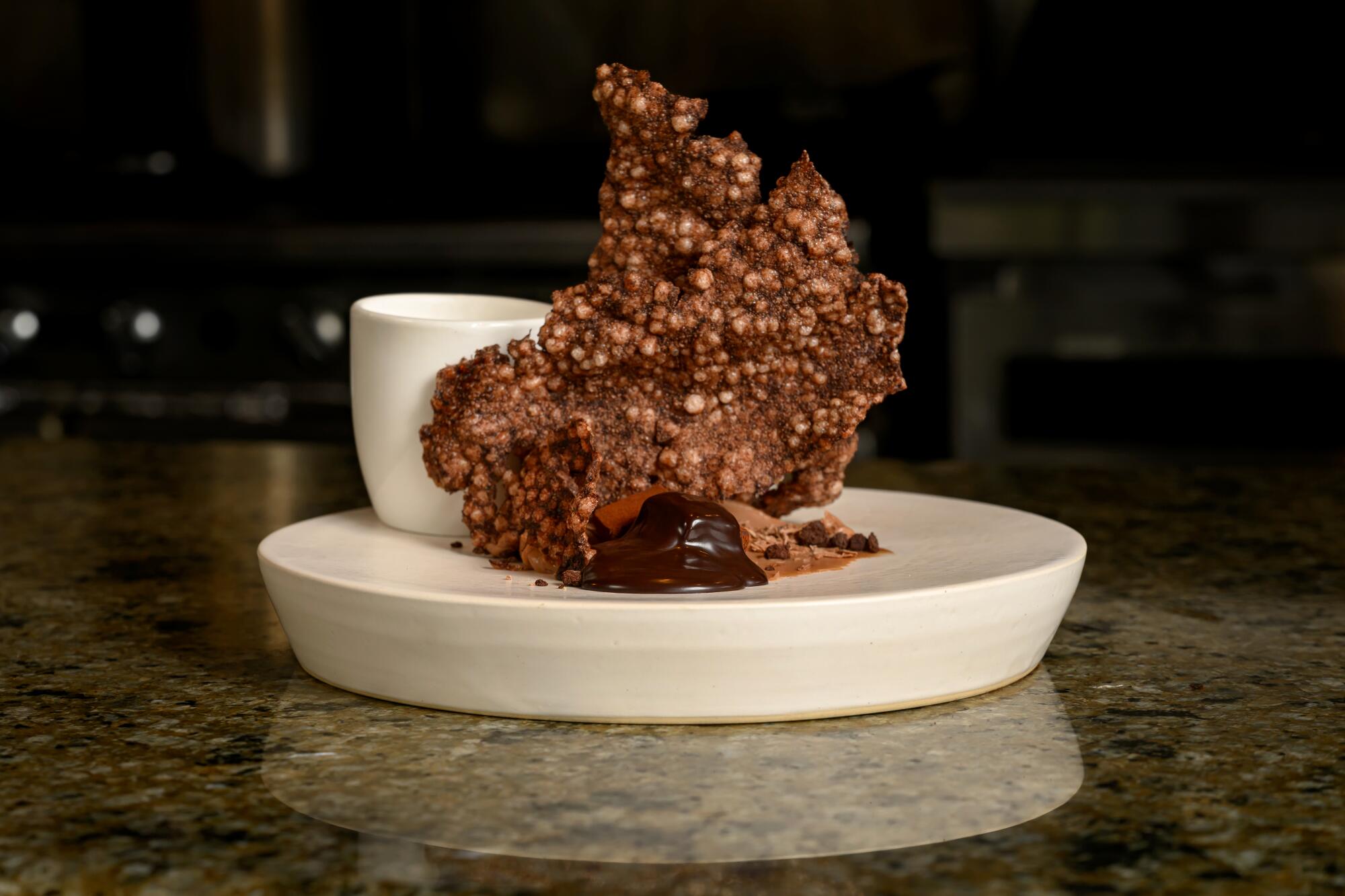
- Share via
- Vin Folk is the most exciting restaurant to open in the South Bay in recent memory and a shining example of destination neighborhood dining.
- The staff is young and ambitious, with a menu that spans the globe, spurred by specific “memories” shared at the table.
- A few dishes, though, get lost in the plot.
“Hi, I’m chef Jude. I’ll be taking care of you this evening.”
A young man in pristine chef whites greets our table at Vin Folk, a petite, bucolic restaurant on the northern edge of downtown Hermosa Beach. He has an earring in each ear and a grin that reaches his eyes.
I wonder if he may have lost his way to the kitchen.
“We’re a chef-driven restaurant,” he says. “You’ll see that most of us are wearing chef coats.”

He launches into a speech about how the restaurant is attempting to do away with the traditional “front of the house and back of the house” system. It’s an explanation that takes at least a minute. Then he asks if he can take our drink order.
I inquire about a bottle of white Nebbiolo.
Restaurant critic Bill Addison and columnist Jenn Harris rank the 101 best restaurants in Los Angeles.
“Oh, I don’t drink yet,” says Jude, confirming he’s not yet old enough to legally consume alcohol. “But I’ll get a staff member more familiar with the wine list.”
The future of L.A. dining might indeed be found in this teensy dining room.
Located just a block from the strand, it’s a bright spot in an area dense with acai bowls, coffee shops and sports bars. Half the diners on any given evening are couples dressed for a night out. The other half are seated on the patio, with dog leashes wrapped around their wrists, Hokas and flip-flops on their feet and the look of someone who may have spontaneously wandered over from their oceanfront home.

The dining room crackles with the hopeful, earnest energy of a start-up company, ripe with possibility. And with food that has all the technique and precision of a tasting menu restaurant with less of the fuss, it is without a doubt the most exciting place to eat in the South Bay in recent memory.
The menu is a jaunt through chef-owner Kevin de los Santos and chef-partner Katya Shastova’s backgrounds and travels, each dish attached to one or more specific “memories” that your chef will share throughout the evening.
The mussels tart ($25) is both precious and picturesque, the kind of plate you feel compelled to pull out your phone for and photograph, even if you don’t normally do that sort of thing. Inspired by a summer trip to Europe before opening the restaurant, the two remember traveling through Portugal, dining on tins of fish, bread and wine.

The dish is a love child of mussels in escabeche and pot pie, with a diamond of puff pastry that acts as a golden, high-walled bed of crust on the plate. Nestled in the center is a smoked fennel cream studded with bits of crunchy fennel and smoked clams. Arranged in a neat row over the top are mussels in escabeche — plump, tart and tangy. A curled nub of pastry is playfully arranged at one corner of the diamond like the lip of a steel tin.
Jenn Harris reviews the newly reopened Panda Inn restaurant in Pasadena, where you’ll find sushi, Yangzhou specialties and the classic orange chicken.
You shatter the flaky crust, sending shards of pastry into the cream and mussels, the combination at once rich, acidic and balanced.
The bivalves may be painstakingly placed with multiple pairs of tweezers. And throughout the evening, the staff will yell a taut, loud, “Oui!” to confirm tickets in the kitchen. But this is not a place that takes itself too seriously.

De los Santos and Shastova are making an effort to mentor the staff with a style of service they learned while working at Somni, Aitor Zabala’s fine dining restaurant now located in West Hollywood. At Vin Folk, which opened in November, staff are trained in multiple positions, both in and out of the kitchen. Everyone helps with prep, then De los Santos and Shastova play a game of chess with the staff, placing members in positions where they may be strongest.
“We are teaching them,” says Shastova. “You go through everything because we believe it’s important to learn every single detail of the restaurant if you want to have your own one day.”
It’s a system that breeds an enthusiastic crop of chefs who beam with pride at the presentation of each dish, all hands having contributed to its creation. It also makes for a cozy, often crowded dining room, with the back of the restaurant occupied by chefs clustered together in the open kitchen, hovering over plates of food.
The headcheese toast ($15) is a loose interpretation of the patty melt at Langer’s Deli in Westlake. It’s a slice of head cheese made from slow braised pork head and shoulder over a piece of Hokkaido milk bread with a spoonful of sauerkraut and a piece of New School American cheese. On the side is a smidgen of mustard so hot it makes your nose tingle.
The melted, almost waxy cheese catapults the toast into another dimension of richness. A modicum of mustard yanks the flavors back to earth.
A bowl of pritto ($20), according to the chef who served the dish, is the restaurant’s take on Taiwanese popcorn chicken. Chunks of zucchini and nuggets of Jidori chicken thighs are coated in potato starch and whipped egg whites for a delicate coating with a fleeting crunch. There’s a dusting of togarashi powder hot with the numbing sensation of Sichuan peppercorns. It’s the dish that everyone at the table keeps coming back to, nibbled on absentmindedly while you contemplate a second glass of wine.
Partner and beverage director Christina Montoya put together a short list of lesser-known, small producers. Wine inquiries are usually met by sommelier-in-training Idean Hashemian, who floats around the room, quick to offer a taste of Brooks Amycas white wine or the Trail Marker Wine Co. Chardonnay, depending on your order. He’s patient and personable, demonstrating the same eagerness as the chefs, every pour accompanied by a tidbit about the winemaker.

Without a full liquor license, the cocktails are either low or no alcohol. The Lower Negroni has the same bitter citrus bite as the classic Italian aperitif cocktail with the addition of warm chocolate bitters. The Zen-Cha Spritz with tea, cava and mint tastes like it’s made to sip with an ocean breeze.
The strongest dishes tend to be anchored by the chefs’ most vivid memories. Beef tongue ($23) is an homage to Shastova’s childhood in rural southern Russia. It’s prepared the same way her mother made it: simmered for hours, then rested overnight in a pool of its own juices. The tongue is painted with a dehydrated tomato skin glaze that turns sweet on the charcoal grill, then splayed over a bed of grated tomato spiked with horseradish.

It’s fatty and exceptionally tender, with a rich, focused beefy flavor free of any offal tang.
The roast chicken ($60), one of the few large-format dishes at the restaurant, is nearly upstaged by the black-eyed pea cassoulet beneath it. The beans are creamy and luxurious, saturated with a mixture of emulsified butter and chicken drippings.
Darkroom in Santa Ana has a black-as-night dining room, unpredictable menu and its own cool vibe. Jenn Harris reviews.
Pastry chef Lei Elmann and De los Santos turned their childhood breakfast memories of eating Koko Krunch cereal in the Philippines into the restaurant’s most striking dessert ($20). It’s composed of squares of milk chocolate crémeux that melt on the tongue, a “soil” of chocolate crumbles, grated chocolate infused with guajillo and jagged hunks of cocoa crackers like fragments of puffed chocolate rice cereal. A smooth chocolate Amaro sauce is poured over the top, and off to the side is a small cup of warm milk. The dish is finished by grating asin tibuok over the plate, a bulbous mass of Filipino sea salt that looks like a fractured dinosaur egg.

Swipe a piece of the cracker through the Amaro sauce. Pop a chocolate square into your mouth. Build a spoonful of chocolate soil. The intensity of the chocolate builds to a crescendo of cocoa, then subsides with a sip of milk.
At times, not everything clicks, with some dishes feeling overly complicated or disjointed. A beef tartare ($22) meant to mimic the flavors of Chinese char siu involves a grocery list of ingredients including flax seed and beet root pulp crackers. The beets overpower the beef and muddle any nuance in the tartare. The garganelli ($30) feel tough and out of place in a sauce nantua that eats more like a thick paste than the classic crayfish butter cream sauce.
And sometimes, the “memories” shared when serving a dish can be a little distracting. During one visit, I was told the chili crab ($42) was inspired by the classic Singaporean chili crab, something De los Santos often ate in the Philippines and Singapore. It’s a crab with global recognition, served throughout Southeast Asia drowning in a sweet chili sauce laced with shrimp paste and marbled with egg. Then, I was also told that it’s an homage to the Santa Barbara crabbing boat that Shastova worked on for five months during the COVID-19 pandemic. Those two disparate memories become a bowl of Venetian-style risotto with a small mound of rock crab meat sourced from that same crabbing boat and a fried egg espuma in the middle.

During the near-minute-long explanation, we inevitably lost the plot of the dish. I dug in a spoon and tried to conjure the taste of Singaporean chili crab, the funk of the shrimp paste, ginger and chili. The risotto was impeccably cooked, each grain a plump oval glutted with crab stock and a compound butter infused with ginger, shallot Thai chile and tomato.
There’s a token resemblance to Singaporean chili crab, if any. But with a bowl of risotto this excellent, there’s really no explanation needed. The food itself is the most compelling story, and with a dining room full of chefs this ambitious, I’m anticipating a happy ending.
Vin Folk
1501 Hermosa Ave., Hermosa Beach, www.vin-folk.com
Prices: Appetizers $12-$25, entrees $20-$95, desserts $8-$20
Details: Open Tuesday through Saturday from 5 p.m. to 10 p.m. Wine, beer and low ABV cocktails. Street parking.
Recommended dishes: Mussels tart, Headcheese toast, Pritto, beef tongue, chili crab, KoKo Crunch.
More to Read
Eat your way across L.A.
Get our weekly Tasting Notes newsletter for reviews, news and more.
You may occasionally receive promotional content from the Los Angeles Times.














